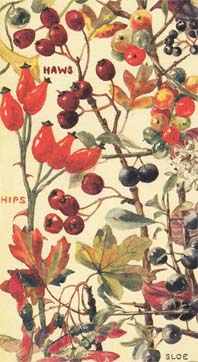 It’s always good to find out that you’ve just been out cycling during a weather warning. That’s what happened to me on Monday morning. I did think that the head wind was a bit stronger than usual on the way home. It made me realise I have been in total denial about Autumn, which is not like me. I love Autumn and am usually ready for the change. Maybe it was because August was so awful and dreary. I don’t know. But Autumn is here and autumn is wonderful. Finch and I have been making pictures by printing with fallen leaves. Conkers are starting to make an appearance. In the hedgerows there are plenty of sloes and haws. No wonder the birds aren’t interested in our garden feeders. Here is a beautiful page from Margaret Erskine Wilson’s book Wildflowers of Britain Month by Month showing a veritable feast of autumn bounty. Over the hill I found a bank of cyclamen, sparkling like little pink and white stars against the mossy greenery. Apparently cyclamen are vital source of nectar for pollinators at this time of year as they build up their stores ready for winter.
It’s always good to find out that you’ve just been out cycling during a weather warning. That’s what happened to me on Monday morning. I did think that the head wind was a bit stronger than usual on the way home. It made me realise I have been in total denial about Autumn, which is not like me. I love Autumn and am usually ready for the change. Maybe it was because August was so awful and dreary. I don’t know. But Autumn is here and autumn is wonderful. Finch and I have been making pictures by printing with fallen leaves. Conkers are starting to make an appearance. In the hedgerows there are plenty of sloes and haws. No wonder the birds aren’t interested in our garden feeders. Here is a beautiful page from Margaret Erskine Wilson’s book Wildflowers of Britain Month by Month showing a veritable feast of autumn bounty. Over the hill I found a bank of cyclamen, sparkling like little pink and white stars against the mossy greenery. Apparently cyclamen are vital source of nectar for pollinators at this time of year as they build up their stores ready for winter.
-
Recent Posts
Recent Comments
- Hannah on Bleurgh
- Sally Farrant on Bleurgh
- Hannah on Half term adventures
- Sally Farrant on Half term adventures
- Hannah on Where I Write
Hannah’s Instagram
Hannah’s Current Reading
Data from Goodreads

Shelley Read

Miya T. Beck


Black Liturgies: Prayers, Poems, and Meditations for Staying Human
Cole Arthur Riley

Archives
- April 2024
- February 2024
- December 2023
- October 2023
- September 2023
- August 2023
- July 2023
- June 2023
- March 2023
- February 2023
- January 2023
- November 2022
- October 2022
- September 2022
- July 2022
- May 2022
- March 2022
- February 2022
- January 2022
- December 2021
- November 2021
- October 2021
- September 2021
- August 2021
- July 2021
- June 2021
- May 2021
- April 2021
- March 2021
- February 2021
- January 2021
- December 2020
- November 2020
- October 2020
- September 2020
- August 2020
- July 2020
- June 2020
- May 2020
- April 2020
- March 2020
- February 2020
- January 2020
- December 2019
- November 2019
- October 2019
- September 2019
- August 2019
- July 2019
- June 2019
- May 2019
- April 2019
- March 2019
- February 2019
- January 2019
- December 2018
- November 2018
- October 2018
- September 2018
- August 2018
- July 2018
- June 2018
- May 2018
- April 2018
- March 2018
- February 2018
- January 2018
- December 2017
- November 2017
- October 2017
- September 2017
- August 2017
- July 2017
- June 2017
- May 2017
- April 2017
- March 2017
- February 2017
- January 2017
- December 2016
- November 2016
- October 2016
- September 2016
- August 2016
- July 2016
- June 2016
- May 2016
- April 2016
- March 2016
- February 2016
- January 2016
- December 2015
- November 2015
- October 2015
- September 2015
- August 2015
- July 2015
- June 2015
- May 2015
- April 2015
- March 2015
- February 2015
- January 2015
- December 2014
- November 2014
- October 2014
- September 2014
- August 2014
- July 2014
- June 2014
- May 2014
- April 2014
- March 2014
- February 2014
- January 2014
- December 2013
- November 2013
- October 2013
- September 2013
- August 2013
- July 2013
- June 2013
- May 2013
- April 2013
- March 2013
- February 2013
- January 2013
- December 2012
- November 2012
- October 2012
- September 2012
- August 2012
- July 2012
- June 2012
- May 2012
- April 2012
- March 2012
- February 2012
- January 2012
- December 2011
- November 2011
- October 2011
- September 2011
- August 2011
- July 2011
- June 2011
- May 2011
- April 2011

 I have been out beating the bounds again…and getting thoroughly lost! One evening I headed out hoping to pick up a lane that would bring me out down river from our house, so as to complete a southerly loop of the parish boundary. Looking at the OS map it seemed fairly simple so I didn’t bother checking street names and of course took the wrong one.
I have been out beating the bounds again…and getting thoroughly lost! One evening I headed out hoping to pick up a lane that would bring me out down river from our house, so as to complete a southerly loop of the parish boundary. Looking at the OS map it seemed fairly simple so I didn’t bother checking street names and of course took the wrong one. The summer holidays are drawing to a close. School re-starts on Tuesday. The fantastic weather over the bank holiday was a great way to end and was worth all the previous weeks of dreariness. We finally launched a little sailing boat Big Dreamer has been working away on renovating. In all the flurry of a new baby and moving house this is a story I haven’t mentioned here.
The summer holidays are drawing to a close. School re-starts on Tuesday. The fantastic weather over the bank holiday was a great way to end and was worth all the previous weeks of dreariness. We finally launched a little sailing boat Big Dreamer has been working away on renovating. In all the flurry of a new baby and moving house this is a story I haven’t mentioned here.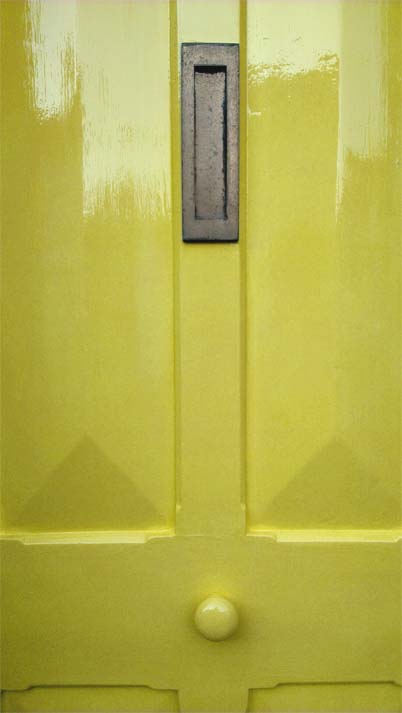
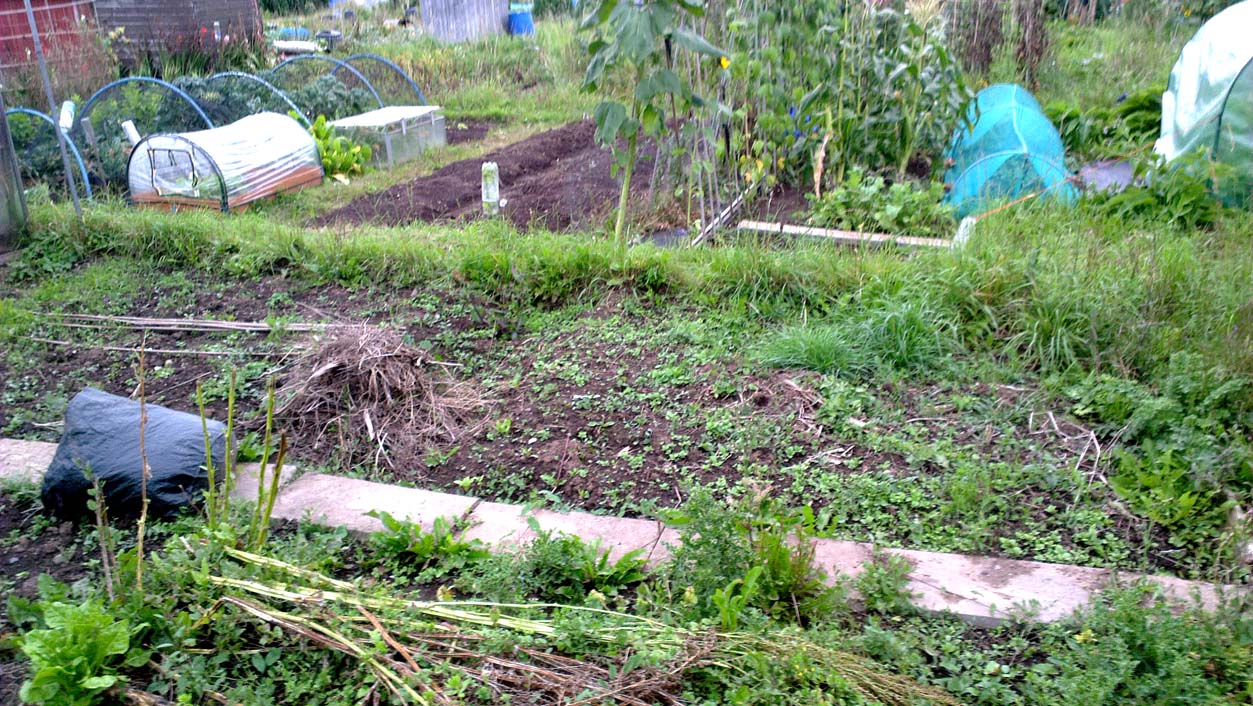
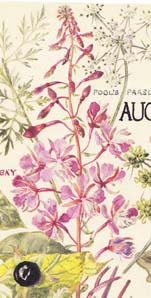 I don’t know about where you are but around us it’s been a dreary old August, not much warmth but plenty of dark grey clouds and rain. Everything is looking very battered and I don’t think my tomatoes are ever going to ripen. Green tomato chutney anyone?
I don’t know about where you are but around us it’s been a dreary old August, not much warmth but plenty of dark grey clouds and rain. Everything is looking very battered and I don’t think my tomatoes are ever going to ripen. Green tomato chutney anyone?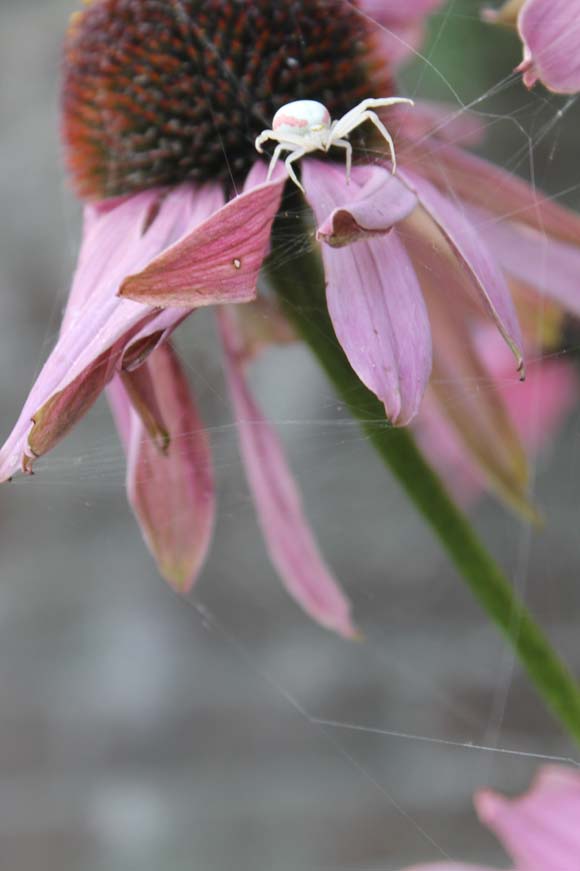
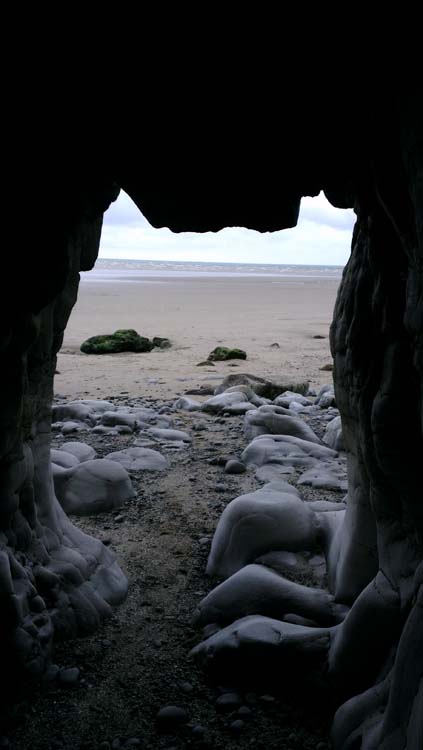 We are back from a lovely week in Wales. Here is a view from a sea cave we explored one day. The last day was showery (it being Wales and all) and we dived into a well-known department store for a coffee. Big Dreamer was most put out when Wren walked up to a male mannequin with her arms up for a carry, and called out “Dada!” Oh dear!
We are back from a lovely week in Wales. Here is a view from a sea cave we explored one day. The last day was showery (it being Wales and all) and we dived into a well-known department store for a coffee. Big Dreamer was most put out when Wren walked up to a male mannequin with her arms up for a carry, and called out “Dada!” Oh dear! During her beating the bounds project, one of the things Dove Grey Reader (blogger extraordinaire) talks about, is trying to be more observant of the flora and fauna through the seasons as she walks the mile circuit she has marked out for herself around her house. I love watching the roll of the seasons, and the cycling changes in the lives of the flowers and insects around me, and I’m always looking for ways to help me be better at noticing these things. It’s part of the reason I’ve been working my way through Margaret Erksine Wilson’s watercolours over the months of this year. So when I spotted a wildflower walk being put on by Devon Wildlife Trust and led by the botanist, Jeremy Ison, I put my name down sharpish.
During her beating the bounds project, one of the things Dove Grey Reader (blogger extraordinaire) talks about, is trying to be more observant of the flora and fauna through the seasons as she walks the mile circuit she has marked out for herself around her house. I love watching the roll of the seasons, and the cycling changes in the lives of the flowers and insects around me, and I’m always looking for ways to help me be better at noticing these things. It’s part of the reason I’ve been working my way through Margaret Erksine Wilson’s watercolours over the months of this year. So when I spotted a wildflower walk being put on by Devon Wildlife Trust and led by the botanist, Jeremy Ison, I put my name down sharpish.
 I have been back walking my loops of the parish boundary (read why
I have been back walking my loops of the parish boundary (read why 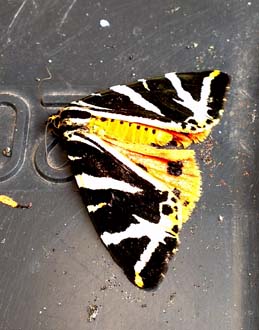 We found this poor chap in our garden yesterday! He must have been brought down by the storm. He’s a Jersey Tiger moth which is a rare day-flying moth. Sadly it’s just a bit rarer now. Little Owl carefully placed him in her bug finder pot and has taken him into school.
We found this poor chap in our garden yesterday! He must have been brought down by the storm. He’s a Jersey Tiger moth which is a rare day-flying moth. Sadly it’s just a bit rarer now. Little Owl carefully placed him in her bug finder pot and has taken him into school.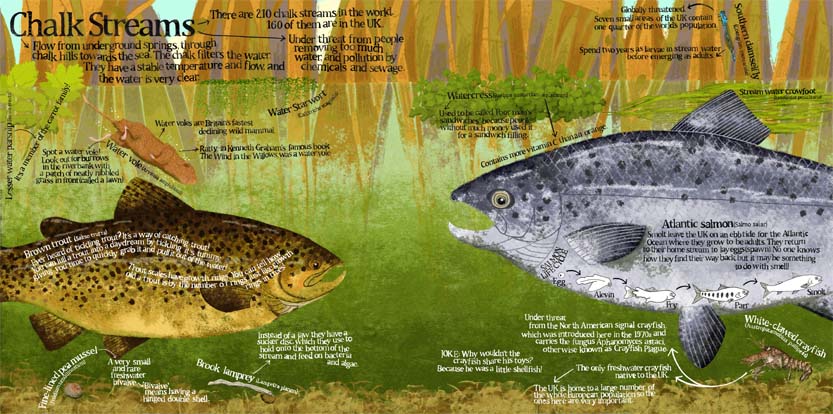 Yesterday an enormous storm rolled in and blew the power at Radio Devon. The kids and I watched in awe from the window as rain pounded the garden. Counting the seconds between lightening strike and thunder clap, the storm stalked towards us, bounded the roof tops with an almighty roar, then rumbled away towards the horizon. My Madonna lilies looked like they’d suddenly developed a life-long smoking habit, the white petals splattered with yellow pollen. But my hollyhocks bore the worst of it. They were dashed to the ground. Little Owl held the broken stalks carefully in her arms and gave me her heartfelt condolences. Needless to say we reached for
Yesterday an enormous storm rolled in and blew the power at Radio Devon. The kids and I watched in awe from the window as rain pounded the garden. Counting the seconds between lightening strike and thunder clap, the storm stalked towards us, bounded the roof tops with an almighty roar, then rumbled away towards the horizon. My Madonna lilies looked like they’d suddenly developed a life-long smoking habit, the white petals splattered with yellow pollen. But my hollyhocks bore the worst of it. They were dashed to the ground. Little Owl held the broken stalks carefully in her arms and gave me her heartfelt condolences. Needless to say we reached for 




